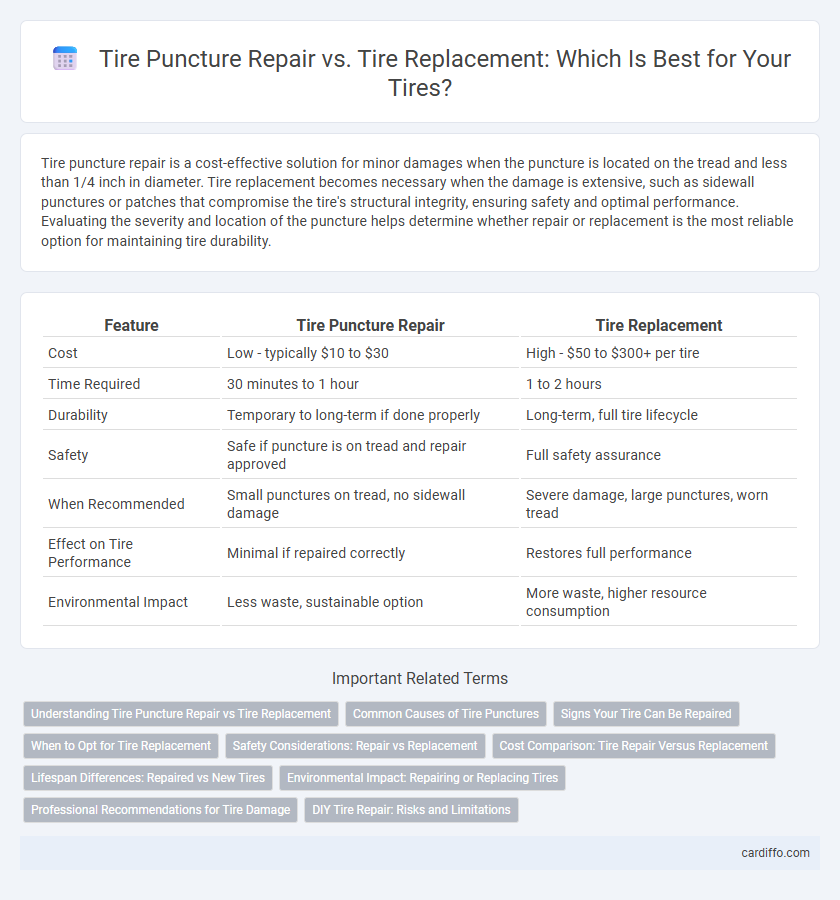Tire puncture repair is a cost-effective solution for minor damages when the puncture is located on the tread and less than 1/4 inch in diameter. Tire replacement becomes necessary when the damage is extensive, such as sidewall punctures or patches that compromise the tire's structural integrity, ensuring safety and optimal performance. Evaluating the severity and location of the puncture helps determine whether repair or replacement is the most reliable option for maintaining tire durability.
Table of Comparison
| Feature | Tire Puncture Repair | Tire Replacement |
|---|---|---|
| Cost | Low - typically $10 to $30 | High - $50 to $300+ per tire |
| Time Required | 30 minutes to 1 hour | 1 to 2 hours |
| Durability | Temporary to long-term if done properly | Long-term, full tire lifecycle |
| Safety | Safe if puncture is on tread and repair approved | Full safety assurance |
| When Recommended | Small punctures on tread, no sidewall damage | Severe damage, large punctures, worn tread |
| Effect on Tire Performance | Minimal if repaired correctly | Restores full performance |
| Environmental Impact | Less waste, sustainable option | More waste, higher resource consumption |
Understanding Tire Puncture Repair vs Tire Replacement
Tire puncture repair is a cost-effective solution suitable for small, centralized punctures in the tread area, restoring tire integrity without compromising safety. Tire replacement is necessary when damage extends beyond repairable limits, such as sidewall punctures, large holes, or severe tread wear that affects vehicle handling and safety. Evaluating tire age, puncture location, and overall tire condition ensures proper decision-making between repair and replacement for optimal driving performance.
Common Causes of Tire Punctures
Common causes of tire punctures include sharp objects such as nails, glass shards, and metal debris that penetrate the tire tread, leading to air leaks. Poor road conditions like potholes and uneven surfaces increase the risk of sidewall damage and punctures, sometimes making tire replacement necessary. Timely tire puncture repair is effective for small tread punctures, but significant damage from road hazards or sidewall injuries often requires full tire replacement to ensure safety.
Signs Your Tire Can Be Repaired
Visible punctures smaller than 1/4 inch, slow air leaks, and localized tread damage are key signs your tire can be repaired safely. Tires exhibiting sidewall damage, large cuts, or multiple punctures typically require replacement for safety reasons. Evaluating the tire's age and tread depth alongside the type of puncture ensures the most effective decision between repair and replacement.
When to Opt for Tire Replacement
Tire replacement becomes essential when the puncture is located on the sidewall or shoulder, where repairs are unsafe and unreliable. Tires with extensive tread wear below 2/32 inch or multiple punctures in close proximity also require replacement to ensure optimal safety and performance. Severe damage such as large cuts, bubbles, or exposed cords mandates tire replacement rather than repair to prevent blowouts and maintain vehicle stability.
Safety Considerations: Repair vs Replacement
Tire puncture repair is a viable option when the damage is limited to the tread area and the puncture does not exceed 1/4 inch in diameter, ensuring the tire retains structural integrity and maintains safe road performance. Replacement becomes necessary if the puncture is on the sidewall, if the tire has multiple repairs, or if there is visible damage to the tire's internal components, as these conditions compromise safety and increase the risk of blowouts. Prioritizing tire replacement in unsafe conditions reduces the likelihood of accidents caused by sudden tire failure, safeguarding both driver and passenger safety.
Cost Comparison: Tire Repair Versus Replacement
Tire puncture repair typically costs between $10 and $30, offering a budget-friendly solution when the damage is minor and located within the tread area. In contrast, tire replacement expenses vary widely, ranging from $50 to over $300 per tire depending on brand, size, and vehicle type, making replacement a significantly higher investment. Evaluating repair versus replacement costs hinges on factors such as tire wear, damage severity, and safety considerations to maximize value and ensure road safety.
Lifespan Differences: Repaired vs New Tires
Tire puncture repair typically restores a tire's function but often reduces its overall lifespan compared to a new tire, as repaired areas can weaken the structural integrity. New tires offer maximum lifespan and performance, usually lasting between 40,000 to 60,000 miles depending on the brand and driving conditions. Choosing repair preserves cost and sustainability short-term, while replacement ensures long-term safety and durability.
Environmental Impact: Repairing or Replacing Tires
Tire puncture repair significantly reduces environmental impact by extending the lifespan of existing tires, minimizing waste and conserving raw materials used in tire production. Replacing tires generates more waste and increases resource consumption, including energy and rubber, contributing to higher carbon emissions. Opting for repair when feasible supports sustainability by lowering landfill contributions and reducing the overall ecological footprint associated with tire manufacturing and disposal.
Professional Recommendations for Tire Damage
Professional recommendations for tire damage emphasize repairing punctures only when the damage is limited to the tread area and the puncture size does not exceed 6mm (1/4 inch). Tire replacement is advised if the sidewall is damaged, the puncture is larger than 6mm, or if multiple repairs have been made previously, as these conditions compromise tire integrity and safety. Experts also highlight that timely assessment by certified technicians ensures optimal tire performance and prevents costly failures.
DIY Tire Repair: Risks and Limitations
DIY tire puncture repair often involves using plugs or patches, which may provide temporary fixes but lack the durability and safety assurance of professional repairs. Improper sealing or incorrect application can lead to air leaks, reduced tire integrity, and potential blowouts, posing significant risks during driving. Tire replacement remains the safer option when damage affects the sidewall, large punctures, or tread separation beyond repair standards.
Tire puncture repair vs tire replacement Infographic

 cardiffo.com
cardiffo.com